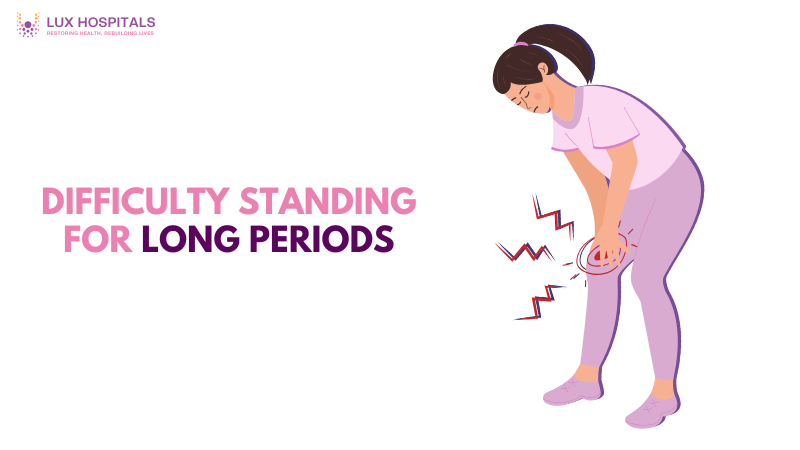Difficulty Standing for Long Periods: A Sign of Underlying Health Issues?

Standing for extended periods can be uncomfortable, especially if it becomes a regular struggle. If you’ve noticed that you’re increasingly having difficulty standing for long periods, you’re not alone. Many individuals experience this issue at some point, but when it becomes a recurring problem, it could be a sign of an underlying health condition.
In this blog, we’ll explore why standing for long periods can be difficult, what it could mean for your health, and what steps you can take to address it.
Understanding the Problem: Difficulty Standing for Long Periods
Everybody has different levels of comfort when standing for extended periods of time. While some people may feel comfortable standing for hours, others may experience pain or discomfort after just a few minutes. Standing can be challenging for a variety of reasons, ranging from poor posture to more serious health issues.
Standing difficulty can manifest in many ways, including tiredness, muscle aches, dizziness, or even swelling in your legs. If you experience these symptoms, they may be your body’s way of signaling that something isn’t quite right.
Common Causes of Difficulty Standing for Long Periods
Poor Circulation
Poor circulation is one of the most common reasons for difficulty standing for long periods. When blood doesn’t flow properly through your legs, it can cause fatigue, swelling, or dizziness. Standing for prolonged periods can exacerbate this issue, as gravity pulls blood down to your legs, making it harder for your body to pump it back up to your heart.
Varicose Veins
You can have varicose veins if you see obvious twisted and bursting veins on your legs. This disorder develops as your veins’ valves deteriorate, making your lower legs swell with blood. Difficulty standing for long periods is common among those with varicose veins, as standing increases pressure on the veins.
Orthostatic Hypotension
Orthostatic hypotension is the term for a sharp decrease in blood pressure that occurs when you stand up fast. This may cause lightheadedness, fainting, or dizziness, making it hard for some individuals to remain standing for long periods. People with this condition often feel the urge to sit or lie down to relieve the symptoms.
Muscle Fatigue or Weakness
Our muscles play a crucial role in keeping us upright when standing. Standing for extended periods can be exhausting if your muscles are weak or fatigued. Conditions like muscular dystrophy or generalized muscle weakness may contribute to this problem, which could also result from lack of exercise or prolonged inactivity.
Joint Problems
Joint conditions like arthritis or other inflammatory disorders can make standing uncomfortable. Standing may stem from stiffness, pain, or inflammation in weight-bearing joints like the knees, hips, or lower back. These issues can be exacerbated when standing for long stretches.
Spinal Problems
Your spine supports your entire body weight, so problems with it, such as a herniated disc or sciatica, can make standing difficult. Pain and discomfort can result from pressure on your spine’s nerves, particularly if you stand for long periods of time.
Chronic Fatigue Syndrome
Chronic Fatigue Syndrome (CFS) is characterized by persistent, unexplained fatigue that doesn’t improve with rest. People with CFS may experience difficulty standing for long periods, often feeling weak and exhausted after a short time on their feet.
How Standing Affects the Body?
Standing for too long without moving can place significant pressure on your muscles, joints, and circulation. Your veins and muscles are designed to work together to help circulate blood throughout your body. When you stand still, your muscles don’t contract and release as they do during walking or other movements. As a result, blood may accumulate in your lower limbs, which may cause pain, edema, or even the feeling that your legs are “giving out.”
Additionally, when your body is forced to stay in a static position for an extended time, your joints and muscles bear the brunt of your body’s weight. Over time, this strain can contribute to wear and tear, leading to difficulty standing for long periods or joint-related issues.
What Can You Do to Ease the Discomfort?
- Move Regularly
Take small steps or try shifting your weight from one leg to the other. every now and then if you have to stand for long amounts of time. Moving around encourages blood circulation and keeps your muscles active.
- Elevate Your Legs
Bring your legs up whether you’re sitting or lying down to help encourage blood flow back to your heart. This can alleviate swelling or discomfort caused by standing for too long.
- Compression Stockings
For individuals with circulation issues or varicose veins, Compression stockings can increase blood flow and decrease discomfort when standing.By gently pressing on the legs, these stockings aid in the veins’ ability to return blood to the heart.
- Strengthen Your Muscles
Frequent exercise can be beneficial, especially cardio and weight training. improve muscle strength and endurance. This will make it easier for your muscles to support your body when standing and reduce the likelihood of fatigue.
- Posture Correction
Improper posture can make standing for long periods difficult. When standing, make sure your weight is appropriately distributed across both legs and your body is in the correct alignment. If you are slouching or leaning to one side, straighten your posture to ease the strain on your joints and muscles.
- Consult a Doctor
If you have severe or ongoing symptoms, you should see a physician for difficulty standing. Such conditions as neurological, arthritis, or circulatory disorders may require professional care or management. Your physician can recommend the course of action and identify the cause of your issue.
When Should You Seek Medical Attention?
If the pain with inability to stand for a long time is accompanied by pain such as intense pain, numbness, swelling, or dizziness, then one should visit a doctor at once. They may recommend serious health complications requiring urgent medical attention, including blood clots, heart problems, or nerve injury.
Conclusion
You shouldn’t ignore standing for a long period of time if it starts to become a frequent occurrence. Standing for extended periods of time might cause occasional discomfort, but persistent or frequent complaints may indicate a severe underlying illness that requires attention.
Knowing the possible reasons and minor changes in lifestyle, like exercising every day and building muscles, can relieve pain that comes with standing. But if pain does not go away, do not hesitate to call a medical care provider for diagnosis and treatment.
Frequently Asked Questions
It could be due to factors like poor circulation, muscle fatigue, joint problems, or conditions like varicose veins or spinal issues. Prolonged standing puts pressure on your muscles and veins, which may cause discomfort or weakness over time.
Weakness upon standing is often caused by low blood pressure (orthostatic hypotension), poor circulation, muscle fatigue, or underlying health conditions like anaemia or neurological disorders. When you stand up, blood may pool in your legs, reducing blood flow to your brain and causing dizziness or weakness.
One of the most frequent reasons people have trouble standing for extended periods of time is poor circulation. Fatigue, edema, and lightheadedness can result from restricted blood flow, particularly in the legs. Peripheral artery disease and varicose veins are two conditions that can worsen the issue by causing poor circulation.
To prevent discomfort, try shifting your weight between your legs, using a footrest, or moving around occasionally to encourage blood flow. Wearing compression stockings, taking regular breaks, and strengthening your muscles through exercise can also help reduce the discomfort of standing for long periods.
Yes, standing for extended periods of time might be challenging if you have varicose veins. Blood can pool in the lower legs as vein valves deteriorate, causing edema, pain, and exhaustion. Long periods of standing can exacerbate this illness, so it’s best to take measures to increase circulation, such as elevating your legs or wearing compression stockings.
It’s critical to get medical help if you suffer from severe or ongoing pain, numbness, swelling, dizziness, or difficulty standing. These symptoms might point to an underlying condition, such as cardiovascular issues, blood clots, or nerve damage, that requires a specialist’s diagnosis and treatment.




















